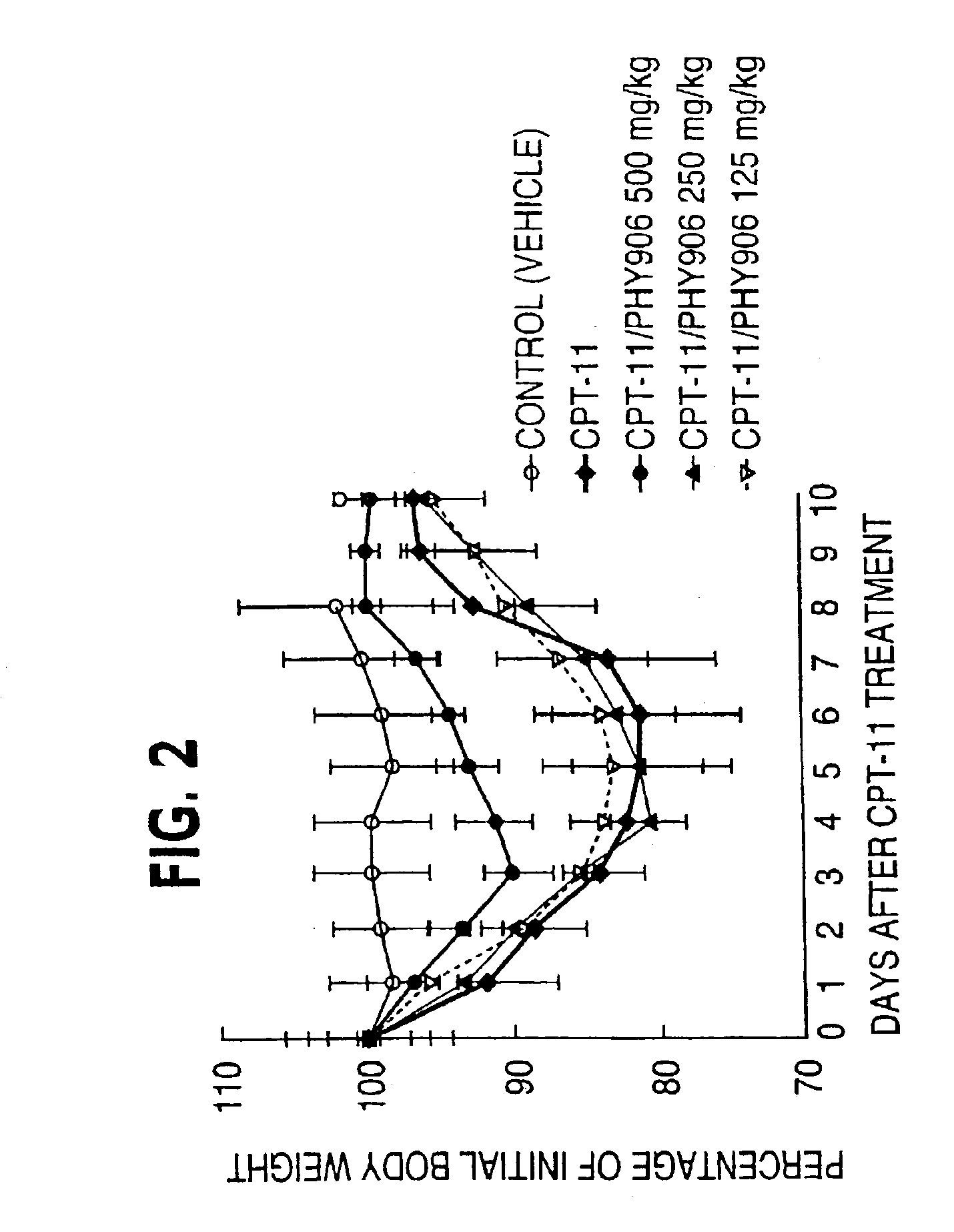Herbal composition PHY906 and its use in chemotherapy
a technology of herbal compositions and compositions, applied in the field of herbal compositions and herbal extracts, can solve the problems of severe toxicity and greater potential for harmful side effects, and achieve the effects of improving the quality of life of chemotherapy, reducing the toxicity of the agent, and increasing the dosage of chemotherapeutic agents
- Summary
- Abstract
- Description
- Claims
- Application Information
AI Technical Summary
Benefits of technology
Problems solved by technology
Method used
Image
Examples
example 1
Evaluation of Toxicity of PHY906 on Different Cell Lines
[0201]Briefly, one gram of each batch of PHY906 was added with 10 ml of water (1 mg / ml). See Table 6 for the batch properties.
[0202]
TABLE 6Batch Properties PHY906PropertyBatch ABatch BOriginTaiwan, Sun-TenTaiwan, Sun-TenPreparation methodStandardStandard
[0203]The supernatant was collected after centrifugation and filtered through a 0.22 m filter. Four cell types were used to test for biological effects of each batch of PHY906: a) KB cells (ATCC cat. # CCL-17); b) HepG2 cells (ATCC cat # HB-8065); c) T-cell lymphoma cell line (CEM cells); d) Colon 38 and e) HCT116 (ATCC cat # CCL-247).
[0204]The carcinoma cells (1×104) were seeded into a 24-well plate in either 1 ml of MEME medium or RPMI-1640 with 10% FBS and 100 μg Kanamycin on day 0. After 24 hours, the PHY906 extract was added to the cells at varying concentrations and incubated at 37° C. for 3 days. The medium was then removed and the cells stained with 0.3 ml of 0.5% (w / v) ...
example 2
Determination of CPT-11 Dose on BDF-1 and Nude Mice
[0208]Animal weight loss was monitored as an indication of toxicity caused by anticancer chemotherapy agents. The effect of CPT-11 on weight loss in non-tumor bearing BDF-1 mice was studied using six different dosages: 100, 200, 300, 400, 600, or 800 mg / kg body weight to determine the maximum tolerable dose in mice. A single bolus dose of CPT-11 was administered intraperitoneally (i.p.) at the beginning of the study, and weight loss was monitored daily for 12 days.
[0209]One dose of CPT-11 was administered i.p. to each mouse at the beginning of the study, and the weight loss of the animal was then monitored daily for 12 days.
[0210]Dosages lower than 200 mg / kg had little effect on body weight (comparison made with control mice receiving no CPT-11 treatments). In contrast, drug doses greater than or equal to 600 mg / kg resulted in animal death on the second day after CPT-11 administration. In general, mice were able to tolerate doses up...
example 3
Effect of PHY906 on CPT-11 Induced Body Weight Loss in Tumor Bearing BDF-1 Mice
[0212]PHY906 was evaluated as a modulator of CPT-11 therapy for toxic side effects in mice inoculated with Colon 38 tumor cells. Based on the previous findings (Example 2), a single bolus dose of 400 mg / kg CPT-11 was selected to study the effect of PHY906 on weight-loss associated with toxicity of CPT-11. To evaluate whether PHY906 impairs the antitumor efficacy of CPT-11, mice were implanted subcutaneously with Colon 38 tumor cells. Ten to 14 days after inoculation, mice were treated with CPT-11 (400 mg / kg, i.p.) in the absence or presence of PHY906, which was given orally twice a day at varying doses (125 mg / kg, 250 mg / kg, and 500 mg / kg). PHY906 treatment was continued at the dose indicated for 8 consecutive days.
[0213]FIG. 2 shows that the effect of PHY906 on weight loss in CPT-11 treated mice is dose dependent. CPT-11 treated animals receiving supplemental treatment with 500 mg / kg / b.i.d. of PHY906 exh...
PUM
| Property | Measurement | Unit |
|---|---|---|
| weight | aaaaa | aaaaa |
| concentration | aaaaa | aaaaa |
| concentration | aaaaa | aaaaa |
Abstract
Description
Claims
Application Information
 Login to View More
Login to View More - R&D Engineer
- R&D Manager
- IP Professional
- Industry Leading Data Capabilities
- Powerful AI technology
- Patent DNA Extraction
Browse by: Latest US Patents, China's latest patents, Technical Efficacy Thesaurus, Application Domain, Technology Topic, Popular Technical Reports.
© 2024 PatSnap. All rights reserved.Legal|Privacy policy|Modern Slavery Act Transparency Statement|Sitemap|About US| Contact US: help@patsnap.com










